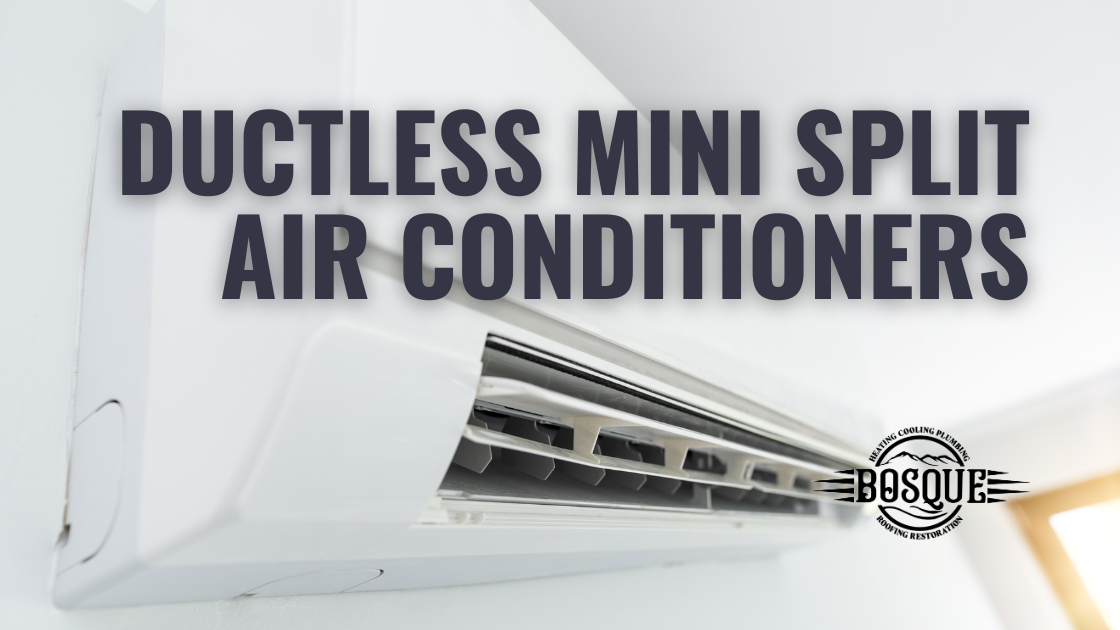Ductless Mini Split Air Conditioners
Maybe you’ve heard of mini split systems before, or maybe you haven’t. Either way, in this article, we’re going to teach you all about mini splits, including what they are, how they work, how mini split systems are different than central air, and when they are the most effective.
And because Bosque Heating, Cooling & Plumbing is an Albuquerque company, we’ll shout out some specific ABQ neighborhoods where we see mini split systems as being an extremely effective cooling solution.
What is a Mini Split?
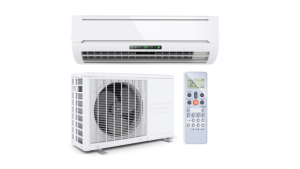
A mini-split is a heating and cooling system that doesn’t require any ducting. For that reason, a mini split is often called a ductless air conditioner. Mini splits consist of both indoor units and outdoor units, much like a central air conditioner.
One outdoor unit can control several indoor units, but you do need to have an indoor unit in each room that you want temperature control. Like central air, mini split systems cool air with refrigerant, a chemical that absorbs heat.
Refrigerant moves through a refrigerant line, absorbing heat from inside and taking it outside to release it.
What’s amazing about mini split systems are that they work in reverse as well. The compressor works as an evaporator when you need the mini split to create heat in the winter.
How Are Mini Splits Different than Central Forced Air Systems?
The main difference between mini splits and forced air is that forced air uses ducting to bring cool air to the various rooms in your home and also pulls air from your home into return air vents, while mini-splits don’t use ducts to move the air.
The only thing moving between the indoor and outdoor units is the refrigerant. Air is pulled into the indoor unit and is cooled right there (via the refrigerant) before it’s pushed back out with a fan.
Mini split systems are much more efficient than central air, so while they can be more expensive to install, they may save users money on their monthly energy bill.
How Does a Mini Split Work?
Mini split systems work by pulling air into the indoor unit of the mini split, cooling it, and the pushing it back out through a fan. But the other necessary piece of the mini split is the outdoor unit—the condenser. One condenser can control several indoor units in individual rooms.
The chemical process that cools the air revolves around refrigerant. Inside the home, the refrigerant begins as a gas. It absorbs the heat in the air, and then becomes a gas.
The gas travels through the refrigerant line to the outdoor unit. In the outdoor unit, the hot line (full of refrigerant as a gas) has a fan that blows on it, blowing the heat away from the home.
Then the refrigerant travels back inside to the indoor unit, and the process starts all over again.
What are Some Pros of Installing a Mini Split?
There are a number of benefits to installing mini splits.
- Older homes with no ductwork. Say residents of an older home with no ducting are tired of using fans, window units, etc., to cool the home, and they want to update with a cooling system. If they choose to install central air, they’ll also need to install expensive and intrusive ductwork. In this situation, a mini split system is far superior.
- Cooling a room that gets particularly hot. Mini splits aren’t just for homes with no AC. In a home with central air, sometimes a south-facing room will get extra hot, and it doesn’t make sense to keep the whole home extremely cold just to keep that one room cool. In this case, installing a mini split to cool that one room is a great solution.
- Mini split systems allow for more temperature control. Because there are separate units in individual rooms, you can set the temperature to be different in each room. Appease your hot sleeper, keep the kitchen cooler while you’re cooking, or whatever you need to make your home more comfortable for everyone.
- They’re more energy efficient than central air systems. Because these units don’t have to move air around your home, they run much more efficiently than central air systems. You can save a lot of money over time on your cooling bills.
What are Some Cons of Mini-Split Systems?
There are many great things about mini split air, but there are some disadvantages too.
- The aesthetics. Some people don’t like that the indoor wall units are quite bulky and protrude from the wall.
- The installation is expensive. Excluding if you’d have to install ductwork, installing mini splits for an entire home is more expensive than installing central AC (about 30% more). Many people think it’s worth it, considering how much money you save over time. If you live in an older home and you would have to have ductwork installed to get central air, it’s definitely worth it to have an HVAC professional give you a quote for each if cost is your main determining factor.
Can Mini-Splits Be Effective for Heating?
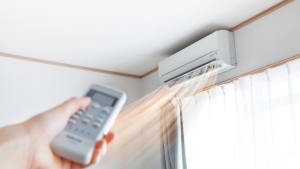 You hear a lot of talk about mini split systems as cooling systems, but they do also work as heating systems. Essentially, the outdoor compressor is key to heating the refrigerant. It can absorb heat from the outside air.
You hear a lot of talk about mini split systems as cooling systems, but they do also work as heating systems. Essentially, the outdoor compressor is key to heating the refrigerant. It can absorb heat from the outside air.
It pressurizes the refrigerant, which increases its temperature. As a result, the refrigerant becomes hotter than the outdoor air, even if it’s cold outside.
Even though it may seem counterintuitive, the refrigerant and the mini split’s components work together to extract heat from the outdoor air, regardless of its temperature, and transfer it into your home. This process allows the mini split to effectively heat your room even during cold weather.
Is There a Case Where a Portable AC or Window Unit Might Be Better?
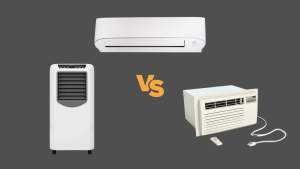 Mini split systems are the most energy efficient solution, are great for increasing the value of a home, and are an ideal long-term solution for older home with no ductwork.
Mini split systems are the most energy efficient solution, are great for increasing the value of a home, and are an ideal long-term solution for older home with no ductwork.
However, there are a few situations when portable air conditioners are better.
- When cost is the most important deciding factor. Window units are fairly inexpensive so they are more accessible to more people.
- You’re renting the home. Obviously, you wouldn’t make an investment in installing a mini split system in a rental. A portable AC unit is a much better choice for a temporary situation.
- You’re not able to access or afford professional installation. A mini split system requires professional installation, and anyone can fairly easily install a window AC.
What’s the Best Case for Installing Mini-Splits?
As an HVAC company in Albuquerque, the most common place we install mini splits are our treasured historic neighborhoods. Homes in these neighborhoods were built without ductwork, so they currently have other heating and cooling solutions.
But especially with our hot summers, as people renovate these homes, they’re often turning to mini split air to make their homes comfortable year-round.
Here are some of the most common neighborhoods in Albuquerque for mini split installations:
- Downtown
- Wells Park
- Plaza Vieja
- Nob Hill
- University Heights
- Summit Park
- North Campus
- Barelas
- Huning Highlands Historic District
Contact Bosque Heating, Cooling and Plumbing for Mini Split Installation
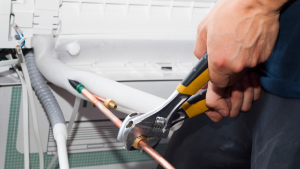 If reading this article makes you realize that a mini split system might be right for your home, we’d love to chat. Bosque’s HVAC specialists can take a look at your home and current infrastructure and let you know what your options are, show you pricing, and let you know the benefits of each system you’re considering so you can get the cooling system that’s right for your home.
If reading this article makes you realize that a mini split system might be right for your home, we’d love to chat. Bosque’s HVAC specialists can take a look at your home and current infrastructure and let you know what your options are, show you pricing, and let you know the benefits of each system you’re considering so you can get the cooling system that’s right for your home.


